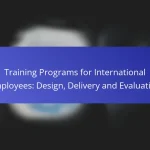Expanding into emerging markets presents businesses with the opportunity to tap into new customer bases and enhance revenue potential while diversifying market risks. However, this venture requires a thorough cost-benefit analysis to evaluate the associated expenses and risks, ensuring informed decision-making regarding market entry and profitability. By systematically weighing the advantages against the costs, companies can strategically navigate the complexities of these dynamic markets.

What Are the Key Benefits of Expanding into Emerging Markets?
Expanding into emerging markets offers significant advantages, including access to new customer bases, increased revenue potential, and diversification of market risks. These benefits can enhance a company’s growth trajectory and overall market presence.
Access to new customer bases
Emerging markets often have large populations with growing purchasing power, providing businesses with the opportunity to tap into new customer segments. For instance, countries in Southeast Asia and Africa are experiencing rapid urbanization, leading to increased demand for various products and services.
To effectively access these new customer bases, companies should conduct thorough market research to understand local preferences and purchasing behaviors. Tailoring products and marketing strategies to meet local needs can significantly enhance customer engagement and loyalty.
Increased revenue potential
Emerging markets typically present higher revenue potential due to lower market saturation compared to developed regions. Companies can often achieve higher growth rates by entering these markets early and establishing a strong presence.
For example, businesses in technology and consumer goods sectors have reported substantial revenue increases after entering markets like India and Brazil. Companies should consider pricing strategies that align with local economic conditions to maximize their revenue opportunities.
Diversification of market risks
Expanding into emerging markets allows companies to diversify their market risks by reducing reliance on a single economy. This strategy can help mitigate the impact of economic downturns in developed markets.
By spreading operations across different regions, businesses can balance fluctuations in demand and currency exchange rates. It is essential to assess political and economic stability in these markets to make informed decisions about risk management.
Enhanced brand recognition
Entering emerging markets can significantly enhance a brand’s recognition and reputation on a global scale. As companies establish their presence, they can leverage local partnerships and marketing channels to build brand awareness.
For instance, brands that successfully localize their offerings often see increased visibility and customer loyalty. Engaging in community initiatives can further strengthen brand perception and foster goodwill among local consumers.
Cost advantages through local resources
Emerging markets often provide cost advantages through access to local resources, including labor and raw materials. Companies can benefit from lower production costs, which can enhance their competitive edge.
For example, manufacturing in countries with lower labor costs can lead to significant savings. However, businesses should ensure compliance with local labor laws and regulations to avoid potential pitfalls related to workforce management.

What Costs Should Be Considered in Emerging Market Expansion?
When expanding into emerging markets, businesses must consider various costs that can impact profitability and feasibility. Key expenses include market entry costs, operational expenses, regulatory compliance costs, logistics and supply chain expenses, and marketing and localization costs.
Market entry costs
Market entry costs encompass the expenses associated with establishing a presence in a new market. These can include legal fees for setting up a business entity, costs for market research, and expenses related to securing necessary permits or licenses.
For example, entering a Southeast Asian market may require significant investment in understanding local consumer behavior and competition, which can range from thousands to tens of thousands of USD depending on the market size and complexity.
Operational expenses
Operational expenses refer to the ongoing costs of running a business in the new market. This includes salaries, utilities, rent, and other day-to-day expenses that can vary significantly based on the local economy.
In emerging markets, labor costs may be lower, but businesses should also factor in potential fluctuations in currency and inflation, which can affect overall operational budgets. It’s wise to prepare for a range of operational costs to ensure financial stability.
Regulatory compliance costs
Regulatory compliance costs involve expenses related to adhering to local laws and regulations. This can include costs for legal consultations, compliance audits, and fees for necessary certifications.
For instance, a company entering the Brazilian market must navigate complex tax regulations and labor laws, which may require hiring local experts, adding to compliance costs that can reach thousands of BRL annually.
Logistics and supply chain expenses
Logistics and supply chain expenses cover the costs of transporting goods and managing inventory in the new market. This includes shipping fees, warehousing costs, and potential tariffs or import duties.
In emerging markets, infrastructure may be less developed, leading to higher logistics costs. Companies should evaluate local transportation options and plan for potential delays, which can impact overall supply chain efficiency.
Marketing and localization costs
Marketing and localization costs are essential for effectively reaching local consumers. This includes expenses for adapting marketing materials, conducting local advertising campaigns, and potentially hiring local marketing teams.
Investing in localization can significantly enhance brand acceptance; however, costs can vary widely. For example, translating and culturally adapting content for the Chinese market may require a budget of several thousand CNY, depending on the scope of the project.

How to Conduct a Cost-Benefit Analysis for Emerging Markets?
Conducting a cost-benefit analysis for emerging markets involves systematically evaluating potential opportunities against associated costs and risks. This process helps businesses make informed decisions about entering new markets by assessing profitability and viability.
Identify potential markets
Start by researching emerging markets that align with your business goals. Look for regions with increasing consumer demand, favorable economic conditions, and potential for growth. Countries in Southeast Asia, Africa, and Latin America often present lucrative opportunities.
Utilize market reports, trade publications, and government resources to compile a list of potential markets. Consider factors such as political stability, regulatory environment, and cultural compatibility to narrow your choices.
Evaluate market size and growth potential
Assess the size of the target market and its growth trajectory. Look for data on population demographics, income levels, and purchasing power to understand the market’s capacity. Markets with a population exceeding several million and a growing middle class are often more attractive.
Analyze industry trends and forecasts to gauge future growth potential. For instance, sectors like technology and renewable energy may show higher growth rates compared to traditional industries.
Assess competitive landscape
Examine the competitive environment in your chosen markets. Identify key players, their market share, and their strengths and weaknesses. Understanding the competition helps in positioning your product or service effectively.
Consider conducting a SWOT analysis (Strengths, Weaknesses, Opportunities, Threats) to evaluate how your business can compete. This analysis will highlight areas where you can differentiate yourself and capitalize on market gaps.
Calculate projected costs and revenues
Estimate the costs involved in entering the market, including operational expenses, marketing, and distribution. Factor in local regulations, tariffs, and taxes that may impact your budget. A comprehensive cost breakdown will help in understanding the financial commitment required.
Simultaneously, project potential revenues based on market size and pricing strategies. Use conservative estimates to create a realistic financial model, ensuring you account for variations in market conditions.
Analyze risks and uncertainties
Identify potential risks associated with entering emerging markets, such as economic volatility, currency fluctuations, and regulatory changes. Understanding these risks is crucial for developing mitigation strategies.
Consider conducting scenario analysis to evaluate how different factors could impact your business. This approach helps in preparing for uncertainties and making informed decisions about market entry.

What Frameworks Can Aid in Decision-Making?
Several frameworks can assist businesses in making informed decisions when considering expansion into emerging markets. These frameworks provide structured approaches to evaluate internal and external factors that impact potential success.
SWOT analysis
SWOT analysis helps businesses identify their internal Strengths and Weaknesses, as well as external Opportunities and Threats in the target market. For example, a company may have strong brand recognition (strength) but limited distribution channels (weakness) in the new market.
When conducting a SWOT analysis, focus on specific market conditions, such as local competition and consumer preferences. This will help clarify whether the strengths can be leveraged to capitalize on opportunities or if weaknesses pose significant risks.
PESTEL analysis
PESTEL analysis examines Political, Economic, Social, Technological, Environmental, and Legal factors that can affect market entry. For instance, political stability and favorable trade regulations can enhance the attractiveness of an emerging market.
Consider conducting a PESTEL analysis to identify potential barriers, such as regulatory hurdles or cultural differences, that may impact operations. Understanding these factors can guide strategic planning and risk management efforts.
Porter’s Five Forces
Porter’s Five Forces framework evaluates the competitive landscape by analyzing the bargaining power of suppliers and buyers, the threat of new entrants, the threat of substitute products, and industry rivalry. This assessment helps businesses understand the intensity of competition in the emerging market.
For example, if buyer power is high due to many alternatives available, companies may need to differentiate their offerings or adjust pricing strategies. Regularly revisiting this analysis can help adapt to changing market dynamics and maintain a competitive edge.


